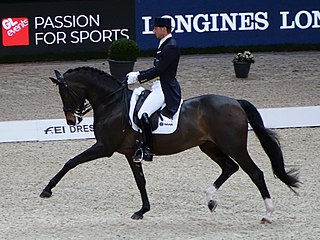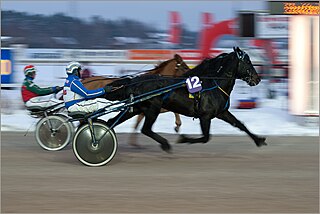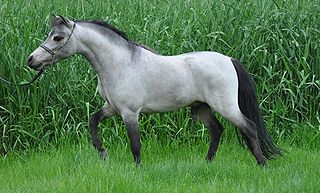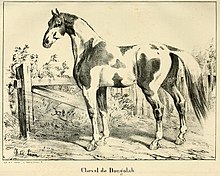
The American Pygmy is an American breed of achondroplastic goat. It is small, compact and stockily built. Like the Nigerian Dwarf, it derives from the West African Dwarf group of breeds of West Africa. Between 1930 and 1960, animals of this type were imported to the United States for use either as zoo animals or for research; some were later kept and bred as companion animals and established as a breed in 1975. It may also be known as the Pygmy or African Pygmy. It is quite different and separate from the British Pygmy breed.
The Foutanké or Fouta is a breed or type of light horse from Senegal, in West Africa. It results from the cross-breeding of a Fleuve stallion with an M'Bayar mare; its conformation is similar to that of the Fleuve. It is one of the four recognised Senegalese horse breeds – the others being the M'Bayar, the Fleuve and the M'Par – and is highly valued for horse-racing.
The Fleuve is a breed of horse from Senegal, in West Africa. Its name is the French word for "big river"; it is named for the Senegal River. It is one of four Senegalese horse breeds, the others being the Foutanké, the M'Bayar and the M'Par.
The M'Bayar is a breed of small horse from the historic region of Baol in Senegal, in West Africa. It is the most numerous of the four Senegalese horse breeds, the others being the Fleuve, the Foutanké and the M'Par.

The Pinzgauer is a breed of domestic cattle from the Pinzgau region of the federal state of Salzburg in Austria. It has distinctive colouring, with chestnut-brown sides and white back and underside. It was in the past a triple-purpose breed, raised for meat, milk and draught use. There is a naturally polled sub-type, the Jochberg Hummel. In 2007 the breed was not considered by the FAO to be at risk.

The Yonaguni or Yonaguni uma (与那国馬) is a critically-endangered Japanese breed of small horse. It is native to Yonaguni Island, in the Yaeyama Islands in south-western Japan, close to Taiwan. It is one of eight horse breeds native to Japan.

The Swedish Warmblood or Swedish Half-bred is a Swedish breed of warmblood horse. It was originally bred as a cavalry horse at the Strömsholm and Flyinge studs. In the twentieth century it became a general-purpose riding and sport horse. It performs well in dressage, show-jumping and three-day eventing, and also as a harness horse.
The Poney du Logone is a breed of small horse or pony from the area of the Logone River in Chad and Cameroon, in west central Africa. It is particularly associated with the Musey or Moussey people of that region, and may also be known as the Poney Musey or Poney Mousseye.

The Latvian Horse is a purpose-bred warmblood horse breed from Latvia. Breeding began in Latvia in the early twentieth century, and a herd book was established in 1927. The breed was officially recognised in 1952. There are two types, sometimes called the Latvian Harness Horse and the Latvian Riding Horse. The harness type was predominant until about 1960, when demand for sport horses increased and more of the saddle type were bred.

The Bashkir or Bashkort is the horse breed of the Bashkir people. It is raised mainly within Bashkortostan, formerly known as Bashkiria, a republic within the Russian Federation which lies to the west of the southern Ural Mountains and extends to the Volga River. The principal centre of breeding is the capital, Ufa.

The Gelderlander is a Dutch breed of warmblood horse. It was bred in the province of Gelderland in the Netherlands as a carriage horse capable also of farm work. It declined in popularity in the mid-twentieth century. In 1965 it was one of the foundation breeds of the Dutch Warmblood or KWPN, the other being the heavier Groninger horse from the north. It is registered in a division of the Royal Dutch Warmblood Horse Studbook, which also has divisions for the Dutch Warmblood and for the Dutch Harness Horse.

The Karabair is a long-established horse breed from Central Asia, and particularly from Uzbekistan and northern Tajikistan. It results from the cross-breeding of desert horses of Arabian or Turkmene type from the south with steppe horses from the north. It is a small, agile and versatile horse that can be used for riding or driving. It is well suited to local horse sports, and especially to the Uzbek national game, kokpar. It is also used for meat and milk production; the milk may be made into kumis.

Ethiopian horses are those breeds or types of horse found in Ethiopia, formerly known as Abyssinia. There are about 2.8 million horses in Ethiopia, more than half the total in the African continent. Ethiopia reports only the Abyssinian breed to DAD-IS. In 2012 the horses of Ethiopia were characterised into eight distinct breeds or types with different regional distributions, including a gravely-endangered feral population, the Kundudo horse.
The Vlaamperd is a South African breed of light draught or harness horse; it is also suitable for riding. It was bred in the Western Cape region of South Africa in the early twentieth century, and resulted from cross-breeding of local mares with imported European stallions, particularly Friesians. The horses are usually black, though mares may be dark seal brown. A stud-book was started in 1983.
The Azerbaijan, is an Azerbaijani breed or group of breeds of riding horse of Oriental type. In 2007 it was listed by the FAO as endangered; in 2021 it was not among the horse breeds reported to DAD-IS.

The Scandinavian Coldblood Trotter consists of two closely related and interconnected breeds of trotting horse: the Norsk Kaldblodstraver or Norwegian Coldblood Trotter and the Svensk Kallblodstravare, the Swedish Coldblood Trotter or North Swedish Trotter. Coldblood trotters are the result of cross-breeding native coldblooded farm horses – in Norway the Dølehest, in Sweden the North Swedish Horse – with lighter and faster horses. Although the Norwegian and Swedish coldblood trotters are substantially considered a single breed, two national stud-books are maintained, and registration requirements differ in some respects between the two countries.

The Boerperd is a modern breed of horse from South Africa. It is a re-creation of the traditional Cape Horse or old-type Boer Horse, which is now extinct.
The M'Par or Mpar is a breed of small horse from the historic region of Cayor in Senegal, in West Africa. It may for that reason be called the French: Cheval de Cayor. It is the smallest of the four Senegalese horse breeds, the others being the M'Bayar, the Fleuve and the Foutanké.

The Pygmy is a British breed of dwarf goat. It is small, compact and generally stockily built. It was established in the 1980s by fusion of the various miniature goat populations of the United Kingdom into a single breed. These were of two principal types: a stocky achondroplastic type derived from the West African Dwarf group of breeds of West Africa; and a small but well-proportioned type derived from the Southern Sudan goat.

The American Miniature Horse is an American breed of small or miniature horse. It has been selectively bred to display in miniature the physical characteristics of a full-sized horse, and usually stands no taller than about 38 in (97 cm). It frequently has the appearance of either a small Arab or a small draft horse; genetically it is no different to pony breeds such as the Shetland.














